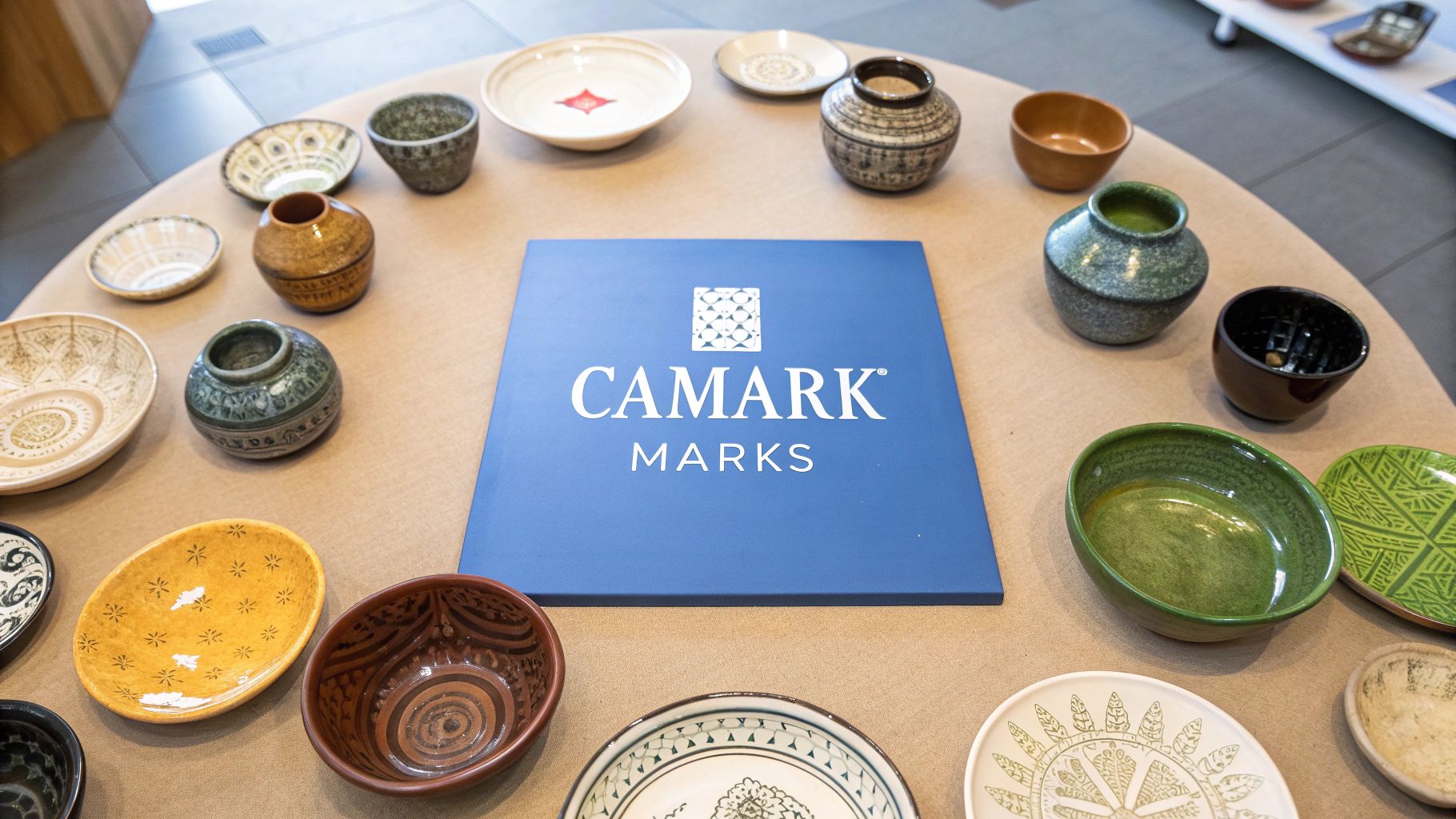Identifying a piece of Camark pottery often starts with a single, crucial detail: the mark on the bottom. These little ink stamps, paper labels, and hand-etched signatures are the fingerprints left behind by the company, telling a story about when and how a piece was made. For collectors, deciphering these marks is the key to unlocking an item's history and value.
This guide is designed to help you do just that. Whether you’re a long-time collector or just found your first piece, understanding how Camark marked its pottery is the first step in your research. The company’s methods changed quite a bit over its nearly 60-year run, so knowing what to look for can tell you a lot.
Your Guide to Camark Pottery Marks
Let's walk through the different eras of Camark production and the marks you can expect to find. The company's history is typically broken down into three main periods, each with its own distinct style of marking.
Key Production Eras and Their Marks
Early Art Pottery (1926-1930s): This was Camark's golden age of high-quality art pottery. Marks from this time are often the most desirable. Look for intricate paper labels, some with shield or scroll designs, which were carefully applied to these early, prized pieces.
Mid-Century Commercial Ware (1940s-1960s): As the company grew, its marking process became more practical and streamlined. During these decades, simple ink stamps like "Camark" or "U.S.A." became common, often accompanied by an incised mold number pressed directly into the clay.
Late Production (1960s-1983): In its final years, the markings became even simpler. Foil labels, usually gold or silver, were frequently used. It's also worth noting that many pieces from this later period were left completely unmarked and sold without any identification.
Camark Pottery was founded in 1926 in Camden, Arkansas, by Samuel Jacob “Jack” Carnes and his associates. The company hit the ground running. By the end of its first year in 1927, Camark already had 25 workers, 65 molds, and over 100 designs, churning out up to 500 pieces of pottery a day from its two kilns. This incredible start quickly cemented its place in American art pottery history. You can learn more about the company's fascinating origins by exploring the detailed history on the Encyclopedia of Arkansas.
To make identification easier, I've put together a quick reference chart that summarizes the most common marks you'll encounter.
Camark Pottery Marks Quick Reference Chart
This table gives you a snapshot of Camark's marks, organized by era. It’s a great tool for quickly narrowing down the age of your pottery when you're out treasure hunting or sorting through a collection.
| Era (Approximate) | Mark Type | Common Characteristics | Example Image |
|---|---|---|---|
| 1926 - Late 1930s | Paper Labels | Ornate designs, often featuring shields, scrolls, or the full "Camark Pottery" name. Glued on after firing. | |
| Late 1930s - 1950s | Ink Stamps | Stamped directly on the base before glazing. Typically "Camark," "Camark U.S.A.," or just "U.S.A." Can be in various colors. | |
| 1940s - 1960s | Incised Marks | "Camark" or a mold number hand-etched or impressed into the wet clay before firing. Often found with an ink stamp. | |
| 1960s - 1983 | Foil Labels | Thin metallic labels, usually gold or silver, with "Camark" or "Camark Art Pottery." Easily lost or damaged. | |
| Various | Unmarked | Many pieces, especially from the later years or those sold as seconds, have no marks at all. Identification relies on form, glaze, and style. |
Keep this chart handy as a starting point. Once you have a good idea of the era, you can dive deeper into the specific glazes and shapes from that period to confirm your identification.
The Story Behind Camark Pottery and Its Marks
To really get a handle on the different Camark pottery marks, you first need to know a bit about the company's fascinating history. Every stamp, label, and signature tells a small part of the story, reflecting a specific moment in the company’s nearly 60-year journey. It all started in Camden, Arkansas, which actually won a competition to become the pottery's home base.
The company was originally founded in 1926 as the Camden Art Tile and Pottery Company. That's a mouthful, so it was quickly shortened to Camark, a clever mashup of Camden and Arkansas. The location was a smart choice, too. It was right in the middle of an economic boom thanks to nearby oil fields, had great transportation options, and, most importantly, plenty of local clay. This strong start helped Camark make a name for itself in the American Art Pottery movement.
From Art Pottery to Commercial Powerhouse
In the early days, Camark was all about high-quality, artist-driven ceramics. The renowned potter John B. Lessell was brought on to design their first lines, which featured stunning iridescent and lusterware glazes. While these pieces were beautiful, they were also expensive to make. These early art wares cemented Camark's reputation, but then the Great Depression hit.
That economic reality forced a major shift. The company had to pivot away from pricey, hand-decorated art pottery and start focusing on more affordable, mass-produced items just to stay afloat. This decision changed everything, from how they made their pottery to how they marked it. The focus moved from individual artists to efficient mold-based production, with an emphasis on creating unique glaze effects. It was this evolution that ensured the company's survival for decades to come.
Camark Pottery operated from its founding in 1926 until production stopped in 1983, a run that spanned major historical events like the Great Depression and World War II. Over those five-plus decades, the company grew from a small art studio into a major commercial player with a nationwide reach. All along, they stayed true to their roots by using Arkansas clay from the Camden area, which gave them great control over material quality and costs. You can get more details on Camark's use of local resources and its full history over at Craftshero.com.
How Historical Events Shaped the Marks
The company’s marking system changed right along with its products. If you look closely, you can see how key historical events and internal business decisions directly influenced the marks you find on the bottom of their pieces today.
- The Great Depression (1930s): This is when you start to see a shift from fancy paper labels to simple, cheap ink stamps. Efficiency was the name of the game.
- World War II (1940s): With metal being rationed for the war effort, ceramic giftware became incredibly popular. Camark’s production exploded, and stamped marks like "USA" became common, reflecting a period of high-volume, patriotic output for a national market.
- Post-War and Late Production (1950s-1980s): As the company turned its attention to novelty items and commercial wares, the markings got even simpler. Foil labels were common, and eventually, many pieces left the factory with no mark at all.
For any collector, understanding this timeline is key. Just like with other collectible ceramics, the company's history gives you the context you need to identify your pieces correctly. To see a similar evolution, take a look at our guide on identifying Carlsbad Austria china marks. Each mark on a piece of Camark pottery is more than just a brand name; it’s a timestamp from a fascinating chapter in American pottery history.
Early Art Pottery Marks: 1926 to the 1930s
When Camark first opened its doors in 1926, its earliest pieces were marked in a way that’s now a holy grail for many collectors. These initial marks, used through the 1930s, often grace the company's most artistic and valuable pottery, produced before the Great Depression nudged Camark toward more mass-market wares. Unlike the stamped marks that came later, these first identifiers were almost always simple paper labels.
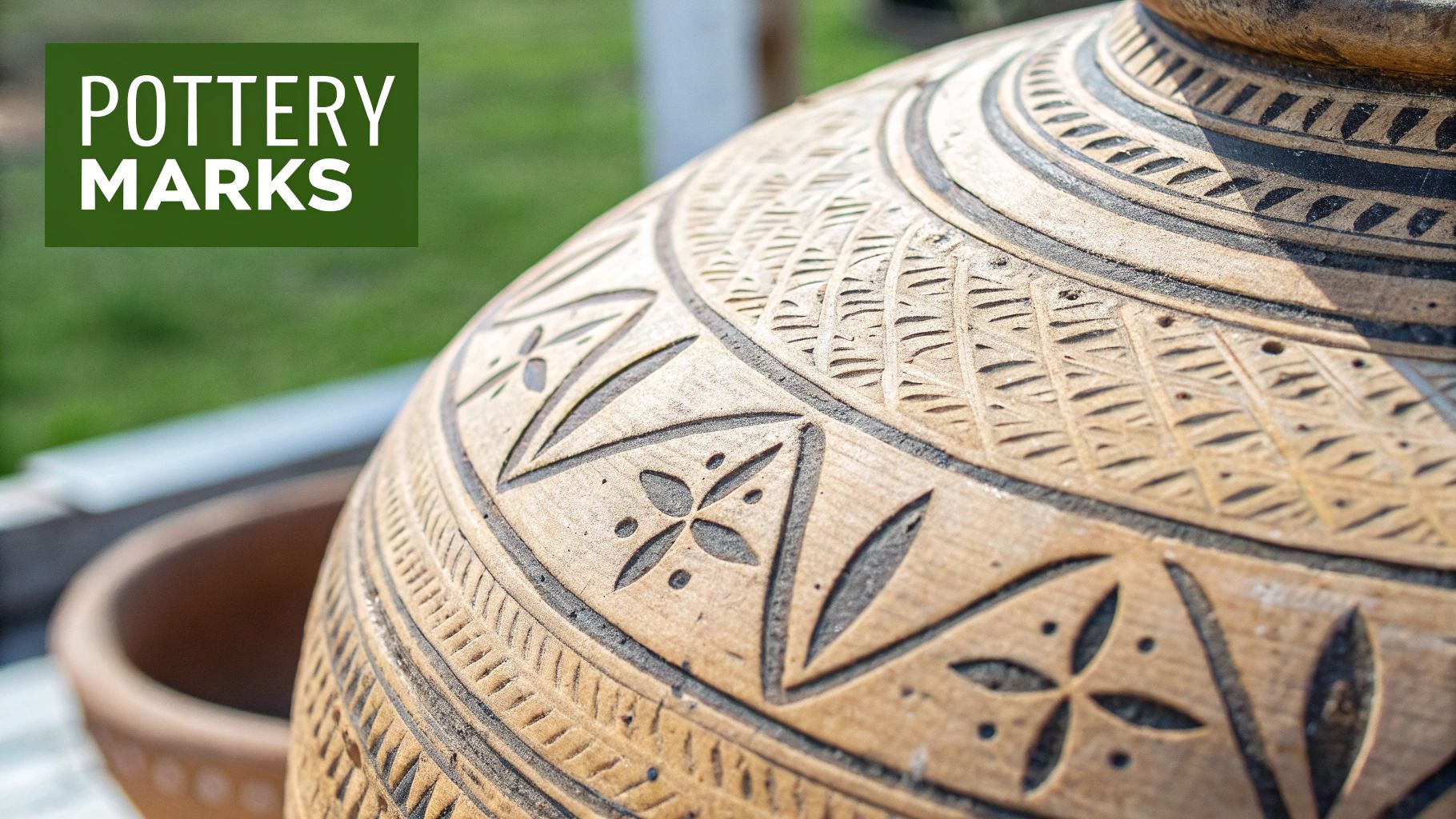
These labels were glued onto the pottery after the piece was fired and glazed. As you can imagine, a fragile paper sticker doesn't always stand the test of time. Many have been washed away, peeled off, or damaged over the decades, which makes finding a piece with an intact early label a real treat. Being able to spot these labels is a fundamental skill for anyone serious about collecting American art pottery.
The Iconic Shield and Scroll Labels
The most famous early Camark pottery marks are without a doubt the paper labels with their fancy shield and scroll designs. These weren't just stuck on any old pot; they were reserved for the top-tier art lines. This includes the stunning and highly sought-after iridescent and lusterware pieces influenced by the great John B. Lessell. These labels were a clear signal of quality and artistry.
Here’s what to look for on these early paper labels:
- Elaborate Graphics: You'll typically see a central shield, often containing a "C" or other artistic flourish. It was usually surrounded by elegant scrolls or banners, giving it a very distinguished look.
- Detailed Text: The text generally reads "Camark Pottery" and might also include "Camden, Ark." or the words "Hand Made." The font was usually a classic serif or script style, which added to the sophisticated feel.
- Color Variations: Most labels were printed with black ink on off-white or cream-colored paper. You might occasionally stumble upon versions in gold or other colors, but those are far less common.
These early paper labels tell a story about Camark's ambition. The company wanted to go head-to-head with established art potteries, and the carefully designed labels were meant to show buyers they were getting a high-quality, artist-made item, not just another piece of ceramic.
How to Authenticate Early Labels
Since these early pieces command higher prices, you have to be careful about fakes. Telling a real vintage label from a modern reproduction is key. A genuine label should show its age in a way that matches the pot it's on. Look for natural yellowing of the paper, some gentle fading of the ink, and a general patina that seems right for the wear on the bottom of the piece.
Context is also your best friend here. Shield and scroll labels belong on early art pottery shapes and glazes. If you see a perfectly crisp shield label on a piece with a 1950s-style pastel matte glaze, your alarm bells should be ringing. For a deeper dive into this kind of detective work, our guide on identifying vintage pottery marks provides excellent tips that work for all kinds of makers. Learning to spot these inconsistencies is a skill you build with experience and by studying known, authentic examples.
Mid-Century Stamped and Incised Marks: 1940s to 1960s
Once the 1940s rolled around, Camark Pottery was a different beast. The early, art-focused days were giving way to full-scale commercial production, and the company’s marking system had to keep up. Gone were the delicate paper labels from the '20s and '30s. In their place came faster, more permanent methods: ink stamps and incised marks cut right into the clay.
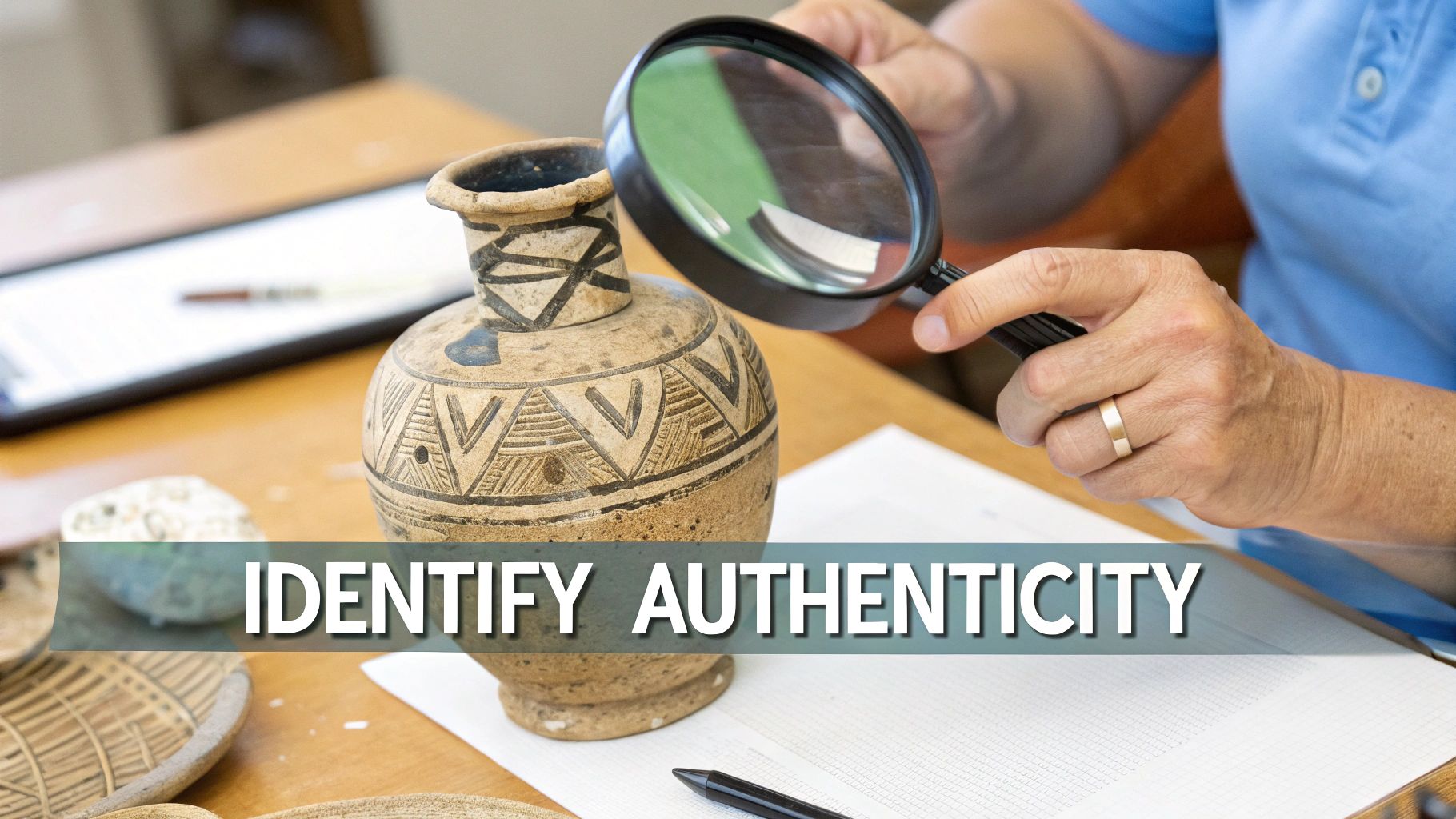
If you have a piece of Camark, there’s a good chance it has one of these marks. This was the company's most prolific period. With the boom in demand for American-made goods during and after World War II, the factory was churning out pottery. They needed a marking system that was cheap, quick, and couldn't fall off. Stamped and incised marks fit the bill perfectly.
Identifying Stamped Ink Marks
Ink stamps were the go-to for identifying Camark's mid-century wares. An employee would stamp the base of a piece before it was glazed, making the mark a permanent part of the finished product. You'll typically see these in black or blue ink, but other colors do pop up now and then.
Look for a few common variations:
- "Camark" in simple block letters or a flowing script. This is probably the most common mark you'll find from this era.
- "Camark U.S.A." This stamp often shows up on pieces meant for broader, national distribution, capitalizing on the post-war patriotism and demand.
- "U.S.A." by itself. When production was at its absolute peak, some items only got a "U.S.A." stamp and a mold number. This can make attribution a bit tricky unless you're familiar with the shapes and glazes.
Pro Tip: Pay attention to how the stamp looks. A really crisp, well-defined stamp often points to an earlier piece from the 1940s. If it’s smudged, faint, or incomplete, it’s likely from later on, when the rubber stamps themselves were getting worn out from constant use.
Understanding Incised and Impressed Marks
In addition to ink, you'll find marks that are physically part of the clay. An incised mark is one that's been hand-carved into the wet clay with a stylus or sharp tool. An impressed mark, on the other hand, is made by pressing something—like a pre-made stamp or a number—into the clay.
For Camark, these marks usually did one of two jobs:
- Brand Identification: Sometimes, instead of using an ink stamp, the "Camark" name was incised by hand. These signatures can vary wildly, from neat, careful script to a quick scrawl that looks like it was done in a hurry.
- Mold Numbers: This is by far the most common reason for an incised or impressed mark. You'll see three- or four-digit numbers pressed into the base. These were purely for factory organization, identifying the shape or design. For instance, a vase marked "531" corresponds to a specific design in the official Camark catalog.
It's very common to find a piece with both types of marks—an ink stamp for the brand and an incised number for the mold. A classic mid-century Camark vase might have a black "Camark U.S.A." stamp right next to an incised "531". This combination is fantastic for collectors, as it gives you everything you need for a confident identification.
Comparing Mid-Century Camark Marks
To help you distinguish between the different marks of this era, it's useful to see them side-by-side. The key differences often come down to the manufacturing needs of the decade, with stamped marks becoming more standardized over time.
| Mark Type | Typical Decade | Key Features | Associated Pottery Styles |
|---|---|---|---|
| Ink Stamp | 1940s–1950s | "Camark" or "Camark U.S.A." in black or blue ink. Clarity can vary. | Solid pastel glazes, modern abstracts, novelty animal figures. |
| Incised Script | 1940s | Hand-scribed "Camark," often inconsistent. Paired with mold numbers. | Early modern forms, transitional art pottery pieces. |
| Impressed Mold Number | 1940s–1960s | 3- or 4-digit number pressed into the clay. Always accompanies another mark. | Virtually all production pottery, from vases and planters to dinnerware. |
Ultimately, recognizing these subtle differences between stamped and incised markings can help you pin down not just the authenticity of a piece, but also a more precise timeline of when it was made.
Late Production and Foil Labels From the 1960s to 1983
As Camark Pottery entered its final decades, running from the 1960s until it closed its doors for good in 1983, the way it marked its wares changed quite a bit. The company was shifting its focus toward mass production and novelty items, so the beautiful paper labels and consistent ink stamps from earlier years were phased out in favor of cheaper, faster methods. This period is really all about foil labels and, just as often, no mark at all.
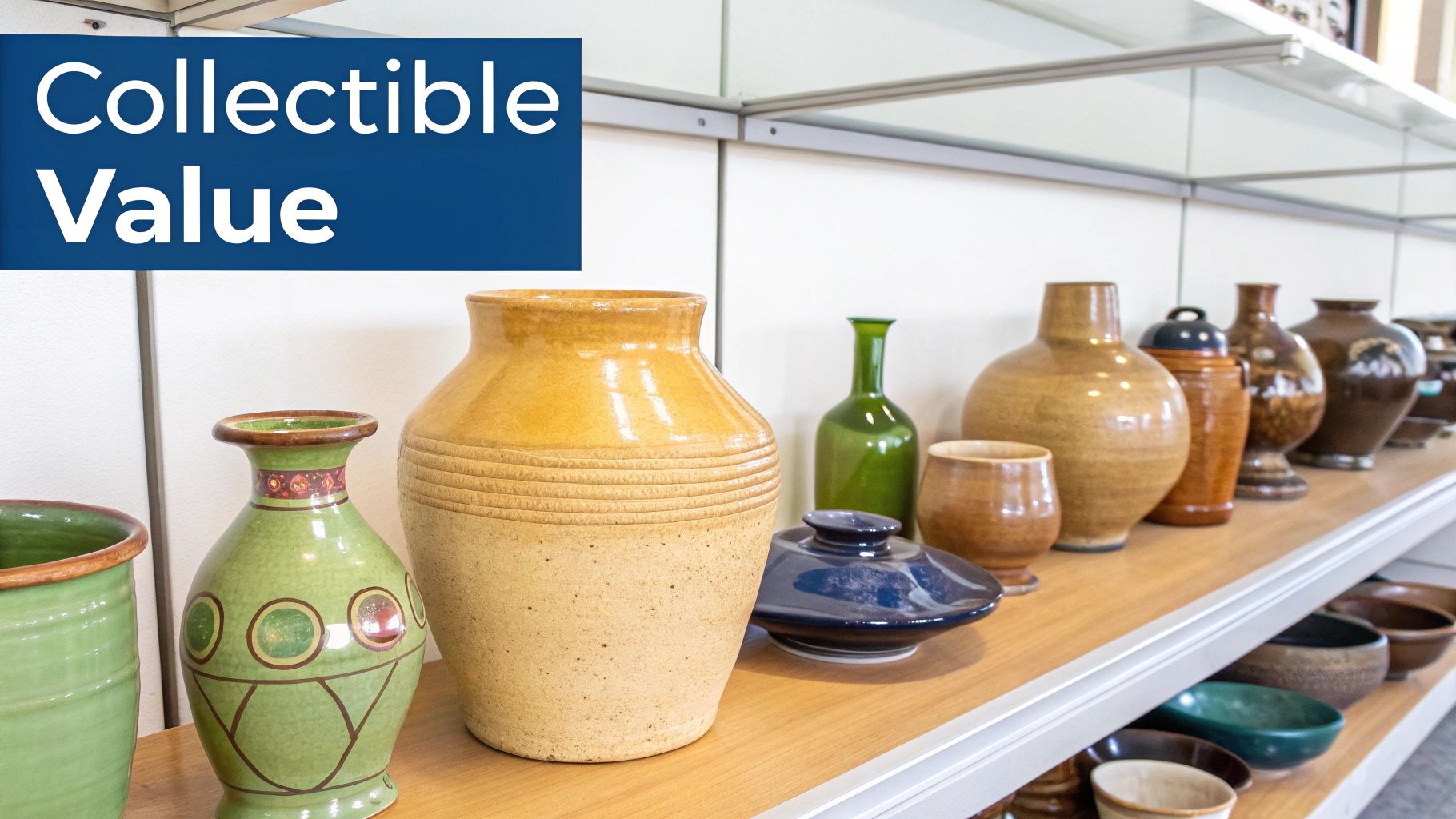
For a collector, this era can be a real head-scratcher. Finding a foil label is a dead giveaway, but since these were just stickers, they’re often long gone. That leaves you playing detective, relying on other clues to figure out what you have. To accurately date pieces from Camark's final chapter, you need to know what to look for, both in the marks they did use and in the unmarked pieces.
The Rise of Gold and Silver Foil Labels
Throughout the 1960s and 1970s, simple foil labels became the go-to branding for Camark. These metallic stickers were a practical choice; they were inexpensive to produce and could be slapped onto finished pieces in a second. This made them perfect for the company’s high-volume output, which included popular items like the "Climbing Cats" and other decorative novelties.
You can usually spot these labels by a few key features:
- Metallic Finish: Most were either bright gold or silver. The shiny finish was meant to catch the eye of a shopper browsing a store shelf.
- Simple Text: The design was minimal. Most just said "Camark" or "Camark Art Pottery" in a very basic font, a far cry from the elaborate labels of the past.
- Shape and Size: They were typically small and came in standard shapes like ovals, rectangles, or circles.
The big problem is that the adhesive on these labels wasn't designed to last for decades. They're notoriously fragile and have often been peeled off by owners or have simply fallen off after years of dusting and washing. Finding a piece from this era with its original foil label still perfectly attached is a rare treat.
The Challenge of Unmarked Camark Pottery
A staggering number of pieces from Camark's later years were sold without any mark at all. As the company wound down its operations, marking just wasn't the priority it once was. This means a huge chunk of late-era Camark pottery can only be identified by its physical traits.
This is where your eye as a collector really comes into play. Identifying unmarked Camark means you have to stop looking at the bottom of the piece and start looking at the piece as a whole. You’re searching for the company's tell-tale signs in the glaze, the shape, and even the weight of the pottery itself, rather than a simple stamp. It's tricky, but with practice, you'll start to recognize the company's "footprint."
Tips for Identifying Late-Period Pieces
If you come across a piece you think might be an unmarked Camark from the 1960s or 1970s, here’s a checklist to run through:
- Recognizable Forms: Compare your item to known Camark shapes. This is especially helpful for their popular novelty lines—the Climbing Cats, various planters, and specific vase shapes are very distinctive.
- Signature Glazes: Camark had a go-to palette of solid and pastel matte glazes during this time. Getting familiar with these specific colors can be one of the strongest clues you'll find.
- Base Characteristics: Even without a mark, the bottom of a piece can tell a story. Look for a dry, unglazed foot ring and the particular weight and thickness that came from Camark's slip-cast production methods.
By piecing these clues together, you can often make a confident identification even without a definitive camark pottery mark. Developing this skill is essential for anyone wanting to build a truly comprehensive collection that covers the company's entire history, from start to finish.
Understanding Mold Numbers and Artist Marks
Once you get past the main company logos, you'll start noticing other little marks on the bottom of Camark pottery. These are usually mold numbers and, if you're really lucky, an artist's signature. Think of these as the finer details that can tell you so much more about a piece's history. Learning to spot them is what separates a casual browser from a serious collector.
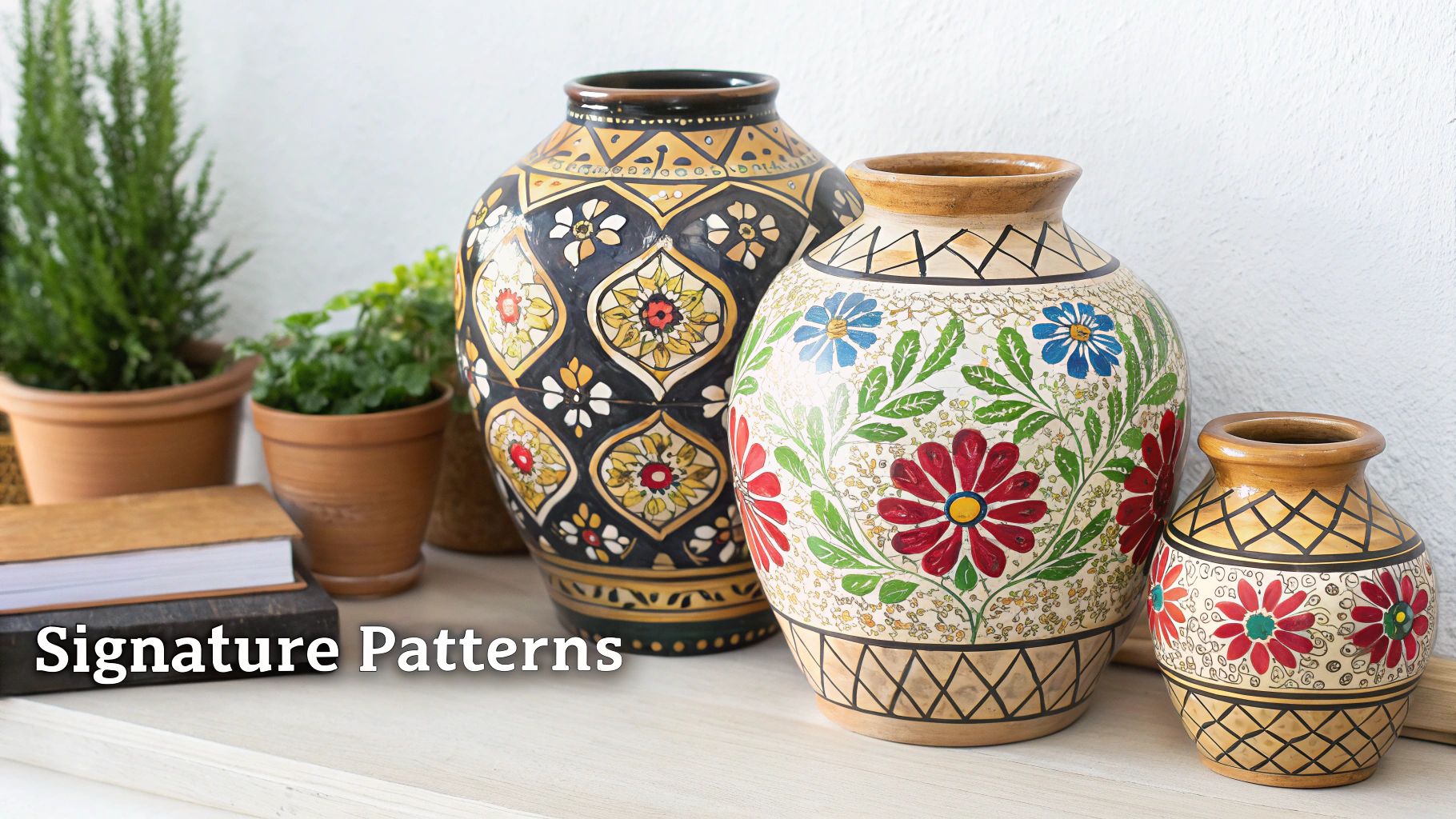
It's easy to overlook these subtle marks, but they’re key to getting a precise ID. They can be the difference between calling something a "mid-century Camark vase" and knowing you have a "Camark mold #531 vase." For collectors, that specific detail is everything.
Cracking the Code of Camark Mold Numbers
The most common mark you'll find besides the main logo is a three or four-digit number pressed or carved into the clay base. This is the mold number. It was Camark's internal code for a specific shape in their production catalog.
These numbers are your secret weapon for identification. For instance, if you see the number "531" stamped on the bottom of a vase, you know it's a specific, documented design. You can look that number up in collector guides or online to confirm the exact shape. This is incredibly helpful for authenticating pieces where the main company stamp is smeared, faded, or missing entirely.
Here's what to know about mold numbers:
- Location: They’re almost always on the bottom, usually somewhere near the ink stamp or incised mark.
- Look: The numbers can be crisp and clear or look like they were scribbled in a hurry. It all depended on who was working the line that day.
- Value: A mold number confirms the shape is an official Camark design, which adds a nice layer of confidence to your identification.
A good way to think about it is that the mold number is like the model number for a car. Knowing you have a "Camark #762 pitcher" is much more satisfying than just having a generic "Camark pitcher."
The Hunt for Rare Artist Signatures
Most Camark pieces weren't signed by the artists who made them, but there are some rare and exciting exceptions. When you do find a signature, it's usually on the early art pottery from the late 1920s and 1930s or on special, hand-decorated items. Finding one is a real treat.
These artist marks show up in a few ways:
- Full Signatures: This is the rarest find. A full name is typically only seen on the earliest, high-end art pieces.
- Initials or Monograms: This is a bit more common. An artist might scratch their initials into the base. They're often tiny and easy to mistake for a random scuff if you aren’t looking for them.
- Decorator Marks: On some hand-painted pieces from later years, you might find small symbols that decorators used to keep track of their work.
Figuring out who made these marks often takes a bit of research, usually by comparing them to examples in collector books. For example, Boris Trifonoff was a key glazer and mold maker for Camark, and his work is sometimes identified. Because so few pieces were ever signed, finding an artist's mark is a direct connection to the person who crafted it, and that always adds to its story and value.
Common Mistakes When Identifying Camark Marks
Getting into vintage pottery is a lot like being a detective, but even the most experienced collectors can get tripped up. When it comes to Camark pottery marks, a few common pitfalls can send you down the wrong path. Knowing what these errors are is the first step to feeling more confident and making sure you know exactly what you've got.
One of the biggest mix-ups happens when people confuse Camark with other big American potteries from the same period, especially those that also came out of Arkansas. For example, Niloak Pottery is another Arkansas original that often gets mistaken for Camark. While both made some incredible pieces, their marks are totally different. Niloak is known for its block-letter logo stamped into the clay, which is worlds away from Camark's usual ink stamps or paper labels. RumRill pottery can also cause confusion for beginners because of some shared styles, even though it was designed by George Rumrill and actually produced by Red Wing.
Faded Marks and Damaged Labels
Another real challenge is the condition of the marks themselves. After decades of being handled, used, and washed, these little identifiers can really take a beating.
- Faded Ink Stamps: Those mid-century ink stamps are notorious for getting faint or smudged. A classic mistake is to write off a piece just because the mark isn't crystal clear. Before you do, grab a magnifying glass and get under some good light. You might just spot the faint outline of the "Camark" script or the "U.S.A." lettering.
- Damaged or Missing Labels: The early paper labels and later foil ones are incredibly delicate. Don't assume a piece isn't Camark simply because the label fell off ages ago. This is where your knowledge of shapes, glazes, and the look of the base becomes your most important tool.
A crucial part of authenticating any piece is looking at the wear on both the pottery and its mark. A genuinely old mark should have wear that matches the rest of the item. If you see a perfect, pristine mark on a piece that otherwise looks its age, that can be a major red flag for a fake or reproduction.
Spotting Fakes and Reproductions
Just like with any popular collectible, fakes are out there. A brand-new, super-bright paper label stuck on an early iridescent vase should make you suspicious. A real 90-year-old label is going to show some yellowing or feel fragile. Similarly, a "stamped" mark that looks a little too perfect or seems to be sitting on top of the glaze instead of slightly under it could be a modern addition.
Ultimately, getting good at this takes practice and a sharp eye. By learning to look past the obvious, you can sidestep these common mistakes and get much better at identifying your finds. For some more general tips that work for all sorts of collectibles, take a look at our broader guide on how to identify antiques. It's full of great advice that can help you build a collection you can trust.
Common Questions About Camark Pottery Marks
When you're digging through flea markets or examining a family heirloom, a few questions always seem to come up about Camark pottery. Collectors, both new and experienced, often run into the same mysteries. This section tackles those common questions head-on, giving you clear, straightforward answers.
Think of this as a conversation with a seasoned collector. We've gathered the questions we hear most often to help you solve those little identification puzzles.
What Do the Numbers on the Bottom Mean?
When you flip over a piece and find a number, that's a key piece of the puzzle. Those digits, usually a set of three or four, are the mold numbers. Each number directly corresponds to a specific shape or design from the official Camark factory catalogs. For instance, a vase marked "531" is a documented, specific form.
These numbers are incredibly useful for a few reasons:
- Positive ID: They let you identify the exact shape, taking the guesswork out of the equation.
- Authentication: Even if a paper label or ink stamp is long gone, a known mold number helps confirm a piece is a genuine Camark design.
- Research: Collectors rely on these numbers to look up items in old catalogs and price guides, giving them a solid reference point for valuation.
Simply put, the mold number is the pottery’s "model number." It's one of the best tools you have for a confident identification.
Is All Camark Pottery Marked?
This is a big one, and the short answer is no. A surprising amount of Camark pottery, especially pieces made in its later years from the 1960s to 1983, left the factory with no mark at all. In that era, the company was focused more on producing large quantities of affordable ware, and marking every single item just wasn't a priority.
This doesn't mean your unmarked piece isn't authentic Camark. It just means you have to play detective. You'll need to rely on other clues, like the unique characteristics of the glaze, the specific shape (which you can check against known mold designs), and the look and feel of the unglazed foot on the bottom.
How Can I Differentiate Camark and Niloak Pottery?
Since both were major Arkansas potteries, it's easy for newcomers to mix up Camark and Niloak. It’s a classic point of confusion. While they were neighbors, their marking styles were usually quite different. Niloak is famous for its die-stamped "NILOAK" mark, which was pressed right into the clay in clean, capital letters.
Camark, on the other hand, used a much wider variety of marks over the years. You'll find everything from paper labels and foil stickers to hand-etched signatures and ink stamps. The most common mid-century Camark marks are ink stamps, which look nothing like Niloak's impressed mark. The best advice is to always compare the mark you have to verified examples from both companies to be sure.
Feeling overwhelmed by all the details? Let Curio do the work for you. Just snap a photo of your pottery, and our app can help identify its origin, history, and potential value in seconds. Stop guessing and start knowing. Download Curio today and turn your mysterious finds into well-documented treasures.
